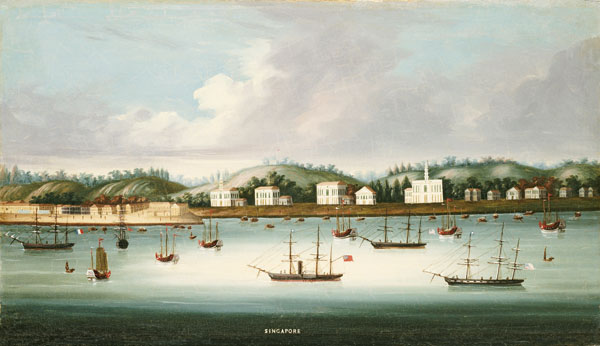Thomas Stamford Raffles (1781-1826) is a man whose name is now better known than his doings. Its syllables conjure a world-famous hotel, a prep-school, the former business class brand of Singapore airlines, a shonky packet of fags, E. W. Hornung’s Raffles the Gentleman Thief, and Viz comic’s Raffles the Gentleman Thug. He also gave his name to a tropical flower that has the largest bloom on earth, and which gives off ‘precisely the smell of tainted beef’.
Most of us will have had the vague sense that he founded modern Singapore (we’re half right about that), and a still vaguer sense that his was a life of glamour, buckle and swash. About that, we are a bit less than half right.
Raffles’s whole career was spent in and around the Eastern Archipelago — Penang, Malacca, Bencoolen, Java — as an employee of the East India Company. In his hardworking, rather short life (he died at 45 of a particularly nasty condition involving a giant veiny lump in his brain called a ‘cerebral arteriovenous malformation’), Tom Raffles rose by charm, application and ingenuity from being an uneducated 14-year-old ‘Extra Clerk’ in India House to senior gubernatorial posts in sweaty and mosquito-ridden outposts of empire.
To the credit side of his ledger was a consistent determination to eradicate slavery and the opium trade, a genuine interest in understanding and preserving the native language, culture, flora and fauna of the places under his command, and a utopian rather than rapacious notion of the way an eastern empire might flourish under a sort of Pax Britannica. He even wrote a History of Java, though not apparently a very good one. To the debit side we could put arrogance, pettiness, vanity, a tendency to take credit for the work of others, a lack of husbandly gallantry (he wrote proudly to his cousin that ‘neither rank, fortune nor beauty’ had influenced his choice of bride) and a slightly elastic sense of financial propriety.
Glendinning’s Introduction pays tribute to his ‘loving heart’ and his ‘unusual resources of energy, curiosity and resilience’. She clearly likes him. ‘He was not a genius,’ she says (the reader will go on to agree), ‘but like all ambitious visionaries, he had a streak of genius.’ I wouldn’t quite say visionary was the word, but he did have an idea: he wanted to expand the Eastern Empire, and he tended not to wait for the official go-ahead before doing so. Given that exchanging letters with the high-ups in London could easily take a year or two, and those high-ups were prone to change their minds, you can’t wholly blame him.
Arranging the invasion of Java was a first bash at it, and the establishment of Singapore was, as the subtitle suggests, his golden opportunity and his lasting legacy. The government and the East India Company — a sclerotic behemoth that Adam Smith had called an ‘absurdity’ five years before Raffles was even born — were happy to reap the benefit when it all turned out fine, though they didn’t exactly give him all the thanks he thought he was entitled to.
Near the end of his life, the foreign secretary wrote to Raffles:
I cannot deny that your extreme activity in stirring difficult questions, and the freedom with which you committed your Government without their knowledge or authority to measures which might have brought a war upon them, unprepared, did at one time oblige me to speak my mind in instructions of no very mild reprehension. But I was not the less anxious to retain the fruits of your policy, which seemed to me really worth preserving.
So, the bare story is all there, and founding Singapore (or co-founding it) is quite something to have on one’s CV. Nevertheless, halfway through this book I thought to myself: ‘Poor Victoria Glendinning!’ She’s a distinguished writer, a careful scholar, and has evidently put the work in. But Raffles — against all expectations — is a truly dull dog. If Sidney Reilly attracted the soubriquet ‘Ace of Spies’, Stamford Raffles could as well have been called ‘Ace of Bureaucrats’.
The author rather touchingly admits it. In Java, she writes:
His most radical reforms were concerned with the currency crisis and the system of land tenure, and are central to an assessment of his administration — though some may warm to the irony of Miss Prism [… ] ‘Cecily, you will read your Political Economy in my absence. The chapter on the Fall of the Rupee you may omit. It is somewhat too sensational.’
Glendinning duly calls that chapter ‘Too Sensational’. Even his friends were rather dull. Raffles’s intellectual soulmate, John Leyden, died of something he contracted from a particularly dusty old archive room. Raffles’s great patron Lord Minto was described by Curzon as having been ‘one of the class of Governors-General who leave no particular mark on history and cease to be remembered either for good or ill’.
At times, Singapore aside, the same seems to apply to our hero. One moment we read that Raffles’s wife Olivia ‘left her mark in Batavia’, but by the facing page we’re assured that ‘Raffles and Olivia were not in Java long enough to effect permanent changes, for good or ill. Those that did last were trivial.’ In Singapore, Raffles set up a ‘Botanic and Experimental Garden’. Is it still there? No. It ‘did not thrive’.
Time and again, something interesting or dramatic threatens to descend, and doesn’t quite. We learn all about the terrible poverty and social unrest in England when Raffles was there in 1817 — but ‘none of this wretchedness impinged on Raffles’. He met Napoleon briefly, on St Helena, and formed a poor opinion of him — but the majority of his 25-page letter on the subject described hanging around waiting. The war he precipitated with the Dutch was only ever a ‘paper war’.
There’s a good bit of pipe-laying prose along the lines of: ‘Archibald Seton was formally signed in as Governor of Penang, though he remained part of the mission to Java. Governor Bruce had died in December 1810, since when W. E. Phillips was Acting Governor in Penang,’ and so on.
Even his relationships with his enemies — he made quite a few — tended to be played out in balls-aching procedural complaints and counter-complaints to company high-ups in India or London. Raffles’s falling out with the military commander William Farquhar — who properly shares the credit for founding Singapore — was mostly conducted at the level of what even his biographer calls ‘bureaucratic trivia’, and included a ‘ludicrous long-running letter-row about a consignment of flooring tiles’. How you start to long for the odd duel. Another enemy, ‘Rollicking Rollo’ Gillespie — drinker, war hero and ‘borderline psychopath’ — shows promise, but then spends most of the book offstage.
Of course, there are moments of drama and human interest. Raffles’s loving relationship with his children is delightful, and the series of catastrophes that took them from him — his second wife Sophia bore him five, of whom only one outlived him — can’t but be affecting. Sophia had made a gold chain bracelet with five gold lockets ‘containing a scrap of hair from each of her children, with their names and dates inscribed on the reverse. Only Ella’s did not have the date of death as well as of birth.’
But such detail is thinner on the ground than the reader would like, and there’s a certain amount of circumstantial padding. It seems possible there was a struggle to find colour in the source material — after all, one of the great late disasters of Raffles’s life was a shipboard fire as he was returning from the tropics that consumed every last one of his possessions, including his voluminous private papers.
That’s tough luck. And ‘print the legend’ is no help to a serious biographer. Still, I regret to say I closed the last page of this biography feeling slightly less interested in its subject than when I opened the first.







Comments